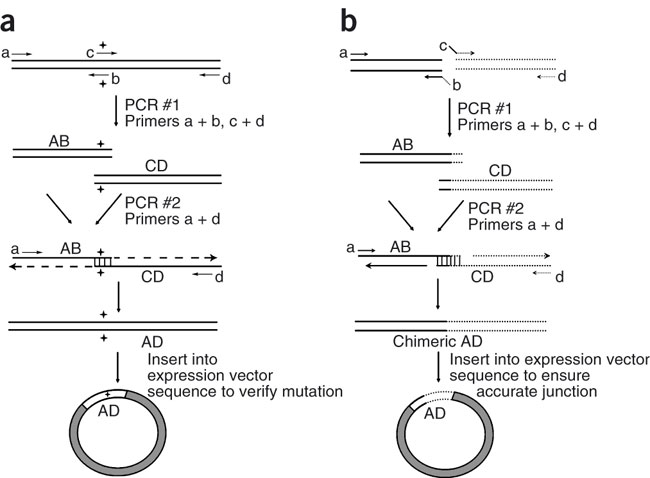|
PCR-mediated overlap extension can create specific nucleotide mutations or generate chimeric gene products.
1. una volta scelto il nucleotide da modificare usiamo i primers c e b che contengono il nucleotide diverso da inserire.Questi due primers sono tra loro complementari.
2. si conducono 2 reazioni di PCR in parallelo: una con i primers a e b e una con i primers c e d
3. mescolando i prodotti di reazione, tra i prodotti del reannealig, ci sarà il segmento AB che si appaia con CD nella zona mutata.
4. Allungamento da parte della DNA Polimerasi che sintetizza in direzione 5'>3'
5.Amplificazione mediante PCR con i primers a e d.
6.Inserimento in un vettore di espressione per verificare e studiare l'effetto della mutazione

Figure a: Site-directed mutagenesis is accomplished by using mutagenic primers (b and c) and flanking primers (a and d) to generate intermediate PCR products AB and CD that are overlapping fragments of the entire product AD. Products AB and CD are denatured when used as template DNA for the second PCR; strands of each product hybridize at their overlapping, complementary regions that also contain the desired mutation (indicated by the cross). Amplification of product AD in PCR #2 is driven by primers a and d. Final product AD can be inserted into an expression vector (gray circle) to generate larger quantities of DNA, which should also be sequenced to ensure the presence of the desired mutation.
Questo approccio basato sull'uso della PCR è veloce e conveniente per sostituzioni semplici. Il metodo è comunque dipendente dalle proprietà delle polimerasi termostabili utilizzate, in quanto non tutte posseggono un'attività esonucleasica 3'-->5': questo può aumentare il rischio di introdurre ulteriori mutazioni non volute durante l'amplificazione di grandi segmenti di DNA.
.......
Figura b
1- Conduciamo in parallelo due reazioni di PCR su due sequenze di DNA non fisicamente unite tra loro: una con i primers a e b, l'altra con i primers c e d. I primes b e c sono solo parzialmente complementari al 5' al filamento di DNA stampo per cui la reazione di PCR produce segmenti di DNA con estremità adesive.
2- Fusione delle sequenze di DNA generate nella prima tappa mediante le estremità complementari dei primers c e d.
3- Allungamento da parte della DNA Polimerasi.
4.Reazione di PCR per amplificare i prodotti di fusione utilizzando i primers a e d.
4- Inserimento del gene chimera in un vettore di espressione per assicurarci di aver ottenuto il risultato voluto.
Figure b: Chimeric gene products can be generated by two PCRs, as in a, except that internal primers b and c are not mutagenic. Instead, because the goal here is to splice together two different gene segments, primers b and c generate overlapping sequences by including nucleotides that span the junction of segments AB (solid line) and CD (dashed line). The second PCR generates the hybrid gene product AD that is then ready to insert into a vector (gray circle) for larger-scale production and verification of the accurate joining of gene segments AB and CD.

.......
|

 don't feel shy, cick on "Edit" and add your information on this page
don't feel shy, cick on "Edit" and add your information on this page